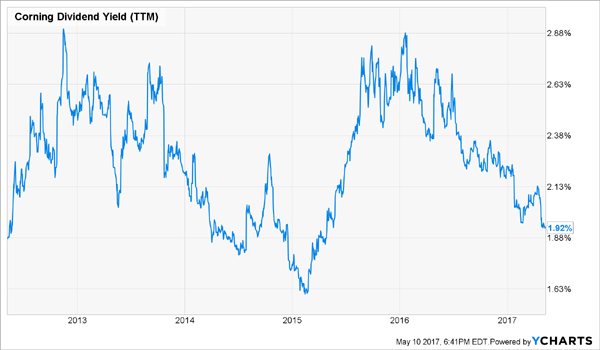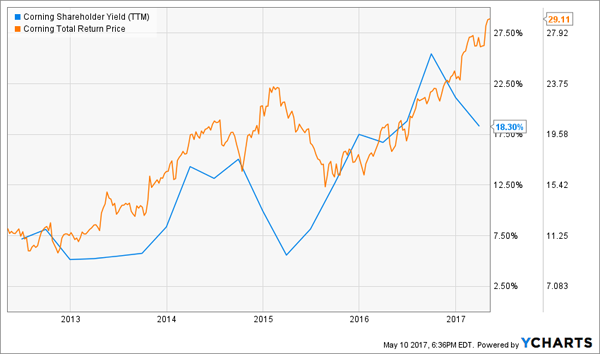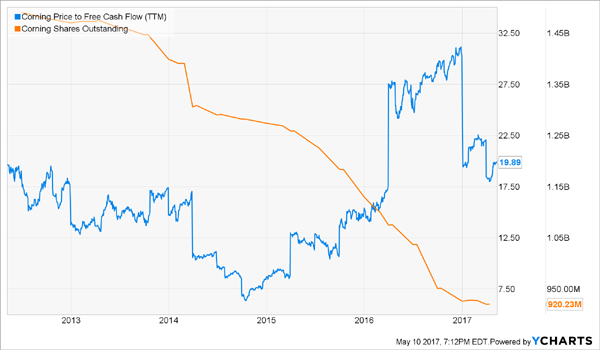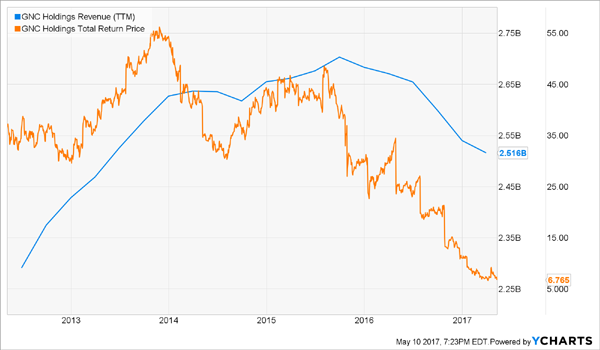You won’t see these “hidden yields” quoted on any financial website. But these firms are showering their shareholders with double-digit yields – and making their owners rich in the process.
The key to finding them? Look beyond the stated yields and focus on the more nuanced (and more valuable) “shareholder yields”.
Take Corning (GLW) for example. The maker of Gorilla Glass never pays more than 3% – if you only look at the current dividend, that is:
Always a Modest 2%+ Yield

But Corning’s shareholder yield – which properly includes money the firm spends on share buybacks – has climbed into double-digits in recent years. Which is the main reason why shares have rewarded investors with 156% returns over the last five years:
Big Shareholder Yields, Big Returns

For example, over the last twelve months, investors received their 2% or so in dividends. But more importantly, they benefited from Corning repurchasing more than 16% of its outstanding shares in just one year.
Add the two up, and you’ve got an amazing 18% hidden yield. Again, you won’t see most of it reported anywhere – but over time, it will drive the share price higher.
Buybacks are underrated as a driver of returns. When the number of shares is reduced, every “per share” metric – dividends per share, earnings, and FCF – all improve. And their increases are leveraged to the amount of stock that is bought back.
After all, if profits are flat while float is reduced by 50%, the result is a 100% increase in earnings per share! And repurchases also support dividend growth. In Corning’s case, it has fewer and fewer shares to “settle up with” every year, so it can hike its payout more than it would otherwise with a static share count.
In a minute, I’ll share 16 stocks that:
- Have repurchased more than 10% of their shares over the past year,
- And yield 1.5% or better.
While the basket of them will probably beat the broader market, you and I can cherry pick the best of the lot by focusing on two rules.
Rule 1: Bargains are Better
Price matters when you and I buy stocks, and it’s no different for companies buying their own shares. If they overpay, they’re wasting money. But if their stock is a bargain, they’re making everyone money.
As recently as 2015, Corning was trading for less than ten times free cash flow (FCF). That’s a “no brainer” valuation, which makes management’s job pretty easy. It’s going to create more value buying back shares than dishing a dividend, in this case.
Check out the orange line below – Corning’s outstanding share count. Management put the pedal to the medal in 2014, when the stock was dirt-cheap. It’s recently started (smartly) to curtail buybacks now that GLW commands a higher valuation:
Smart Buybacks: Double Down When Shares are Cheap

This may be bullish for Corning’s next dividend hike (likely next February), but that’s a payout growth story for another day.
If bargains are good, then buybacks from great businesses are, well, great.
Rule 2: Growing Businesses are Best
GNC Holdings (GNC) meets all the criteria we’ve discussed thus far. The company has repurchased more than 17% of its outstanding stock over the last year and paid and additional 11.8% in dividends.
It’s done everything right for shareholders, and the stock trades for just 10 times FCF today. Problem is, I’m not sure the company still has a business – its brick-and-mortar sales model is being eaten alive by the Internet.
GNC is trying to expand its offerings beyond its traditional “muscle head” base. The firm now sells nutritional supplements such as fish oil and supplements. And the number of transactions per store increased an impressive 9.3% last quarter.
But same store sales are mired in a downward spiral because the average transaction amount was down 12.1% at the same time! Company-wide sales topped out two years ago, and few stocks can thrive without top line growth. Even shareholder yield in the 30% range couldn’t help save this dinosaur:
When Sales Drop, the Stock Price Usually Follows

My Favorite Pick Today (and its 19% Nuanced “Hidden Yield”)
My favorite stock to buy today just dished its shareholders a nuanced 19% “hidden yield” last year. But Wall Street is mistakenly missing this amazing stock because, quite frankly, they’re confused.
This firm put a very smart CEO at the helm in 2014. Rather than coast on the cash cows he inherited, he saw the future growth areas in his industry and used his company’s current clients to get there.
The transition is ahead of schedule. And – get this – the firm is still throwing off enough excess capital to shower shareholders with 19% hidden yields.
It’s the best of both worlds – you get to compound your money today while benefiting from this CEO’s vision for tomorrow. When his transition gets a bit more clear enough for the folks on Wall Street to see what he’s brilliantly doing, his stock will be rewarded with a higher multiple.
I have an email with my full analysis attached ready to be sent to my Hidden Yields subscribers this Friday. Are you a current subscriber of our dedicated dividend growth publication? If not, why not?
I’d be happy to set you up with a 60-day risk free trial. You’ll receive my favorite pick this Friday along with my latest report highlighting 7 more dividend growth stocks with 100%+ upside.
“Efficient market” proponents are dead wrong – you can bank 12%+ annual returns thanks to these types of hidden yields. Click here and I’ll outline the strategy for you in detail – and I’ll also share my 7 favorite buys today, including names, tickers and buy prices.
Stocks With 10%+ Buybacks & 1.5%+ Dividend Yields

